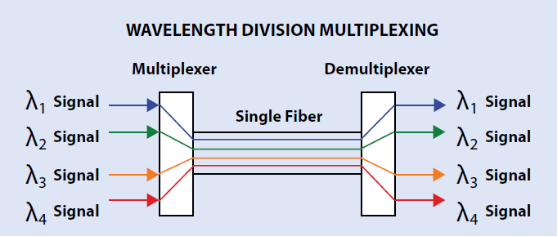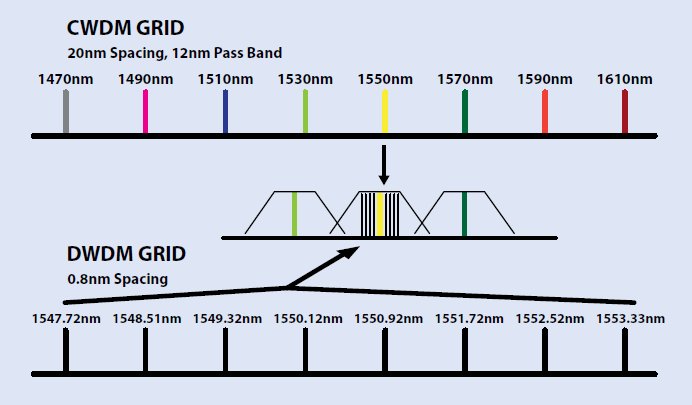- به وبلاگ خود خوش امدید
- Analysis of A Practical CWDM System Deployment Case
- Why Not Use EDFA Amplifier in Long CATV Network?
- Why Not Using DWDM Technology to Build Your Network?
- Optical Transponder—an Important Component in WDM System
- How to Build an Economical Long-haul 500Gbps Metro Network?
- Fiber Optical Communication
- Why Do We Need Optical Transponder (O-E-O)?
- CWDM Technology—Economically Saving Fibers for Your Network
- Confused About Loss in the Long Haul DWDM Network?
آخرین مطالب
امکانات وب
As WDM revolution has already occurred with unanticipated swiftness, WDM technology is largely used in a really fast manner, dramatically promoting the network for high-volume data transmission over a single fiber cable. Have you ever wondered how does WDM technology work? Whatrsquo;s the difference between CWDM and DWDM technology? Which one is the most suitable for your network? To better understand CWDM and DWDM technology, this post will study the working principle of WDM technology and analyze the detailed difference between CWDM and DWDM technology.
Have you ever heard about the working principle of the prism? When a white light beam with different wavelengths pass through the prism, there should be a light dispersion. It will be changed into several light beams and leave the prism at different angles, just like a rainbow. To the contrary, if several light beams with different wavelengths pass through the prism, it will be changed into a white light beam. The following figure shows the details of how does the prism work.

The working principle of WDM technology is similar to the above-mentioned principle. Without using additional fibers, WDM technology uses a multiplexer at the transmitter to combine multiple signals together, and a demultiplexer at the receiver to split them apart as shown in the following figure, so that multiple signals can be transmitted over a single fiber cable.

Thatrsquo;s to say, optical signals with different wavelengths are combined at the transmitter firstly, then will be transmitted together through the single optical fiber. Finally, the combined signals will be split into multiple signals with differing wavelengths again when arriving at the receiver. In the whole transmission process, each signal with its own wavelength will not interfere with each other. Therefore, the capacity of a fiber link can be expanded by simply putting the multiplexer and demultiplexer at each end.
WDM technology is very efficient and largely used that enables the capacity of the network to be expanded without more fibers. In general, it can be divided into two types, CWDM (coarse wavelength division multiplexing) and DWDM (dense wavelength division multiplexing), both of which are indispensable technologies to increase capacity on the fiber links. However, there are many differences between the two types, which vary from wavelength spacing to transmission distance.
Wavelength SpacingCWDM and DWDM are divided on the basis of different wavelength patterns, while the words ldquo;coarserdquo; and ldquo;denserdquo; reveal the difference in channel spacing. As for CWDM, it has the capability to carry up to 16 channels on a single fiber in the spectrum grid from 1270 nm to 1610 nm with a 20nm channel spacing. As for DWDM, it has a narrower channel spacing, 0.8 nm, which is able to transmit up to 160 channels from the wavelengths of 1525 nm to 1565 nm (C-band) or 1570 nm to 1610 nm (L-band). In comparison, the denser spacing and more channels allow DWDM to transmit more optical signals over the same fiber than CWDM. For the basic difference between CWDM and DWDM, you can take the following figure as reference.

CWDM and DWDM use the same working principle to multiplex different wavelengths of optical signal via a single fiber, but differ in applications for the ability to amplify the multiplexed signals. As CWDM has no ability to amplify the signals, it is always used in short distance transmission that can support the transmission at lengths up to 160 km. However, DWDM is designed for longer haul transmission, which can expand greater maximum capacity and transmit the signals longer. Thereby, CWDM is always the first choice for short distance applications, while DWDM could be the priority for long distance transmission.
Manufacturing CostCompared to DWDM, CWDM with uncooled laser uses electronic tuning that is easier to be manufactured with lower cost. Why? Because DWDM with cooled laser is more difficult to accommodate temperature tuning due to the non-uniform temperature distribution in a very wide wavelength, which results in high cost. Meanwhile, DWDM has a much narrower channel spacing which requires more sophisticated transceiver designs. Hence, the manufacturing cost of DWDM is much higher than of CWDM. Typically, a DWDM product is four or even five time more expensive than a CWDM counterpart.
With its advantage of high-volume data transmission over a single fiber cable, WDM technology becomes more and more commonly used and plays an important role in facing the increasing demands of todayrsquo;s network. Along with the constant development and maturity of WDM technology, it is divided into CWDM and DWDM that are indispensable technologies with different features. You are suggested to choose the suitable one for your network according to their features, such as, transmission distance, channel numbers.
برچسب : in depth look at scorpio,in depth look at taurus,in depth look at deleveraging,in depth look at ketogenic diets and ketosis,in depth look at gemini,in depth look at sagittarius,in depth look at lupus symptoms,in depth look at aquarius,in depth look at depression,in depth look at virgo, نویسنده : afiberopticalcom1 بازدید : 48
لینک دوستان
- کرم سفید کننده وا
- دانلود آهنگ جدید
- خرید گوشی
- فرش کاشان
- بازار اجتماعی رایج
- خرید لایسنس نود 32
- هاست ایمیل
- خرید بانه
- خرید بک لینک
- کلاه کاسکت
- موزیک باران
- دانلود آهنگ جدید
- ازن ژنراتور
- نمایندگی شیائومی مشهد
- مشاوره حقوقی تلفنی با وکیل
- کرم سفید کننده واژن
- اگهی استخدام کارپ
- دانلود فیلم
- آرشیو مطالب
- فرش مسجد
- دعا
- لیزر موهای زائد
- رنگ مو
- شارژ
